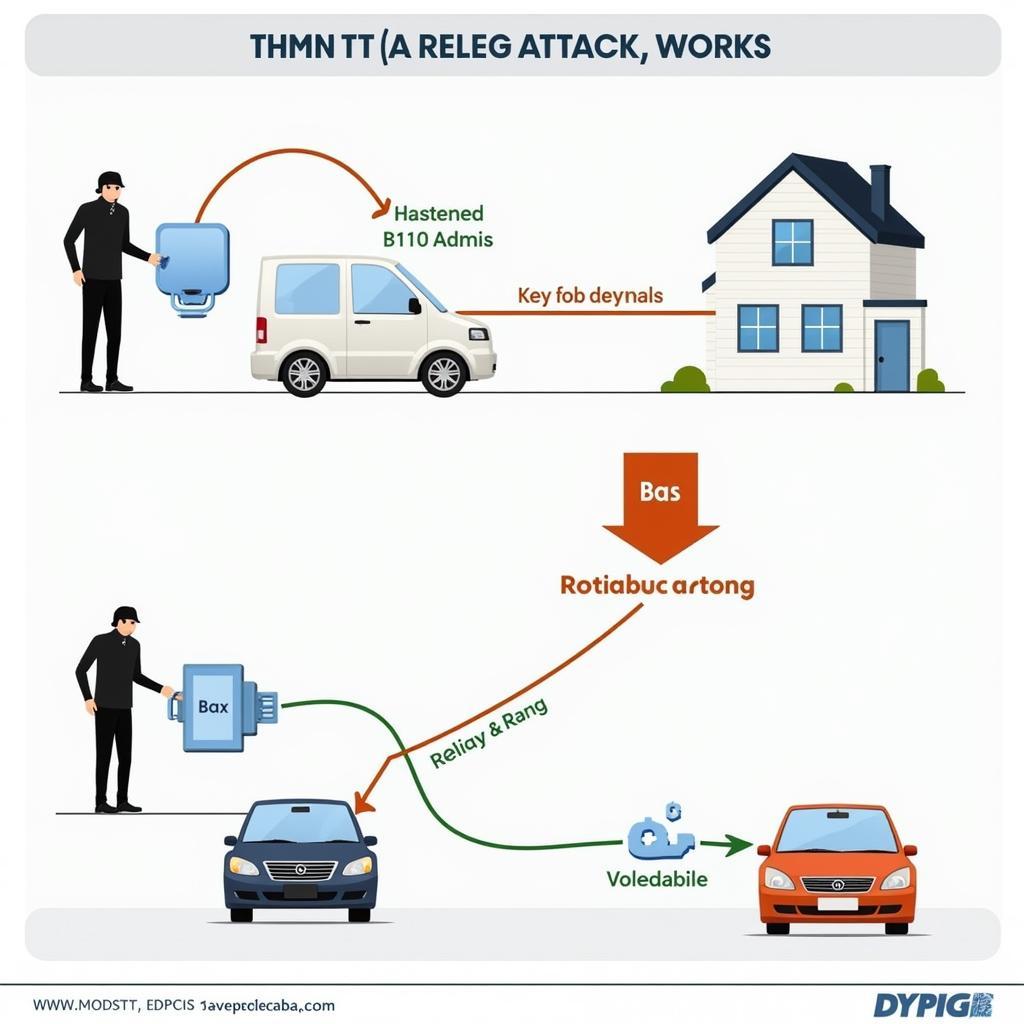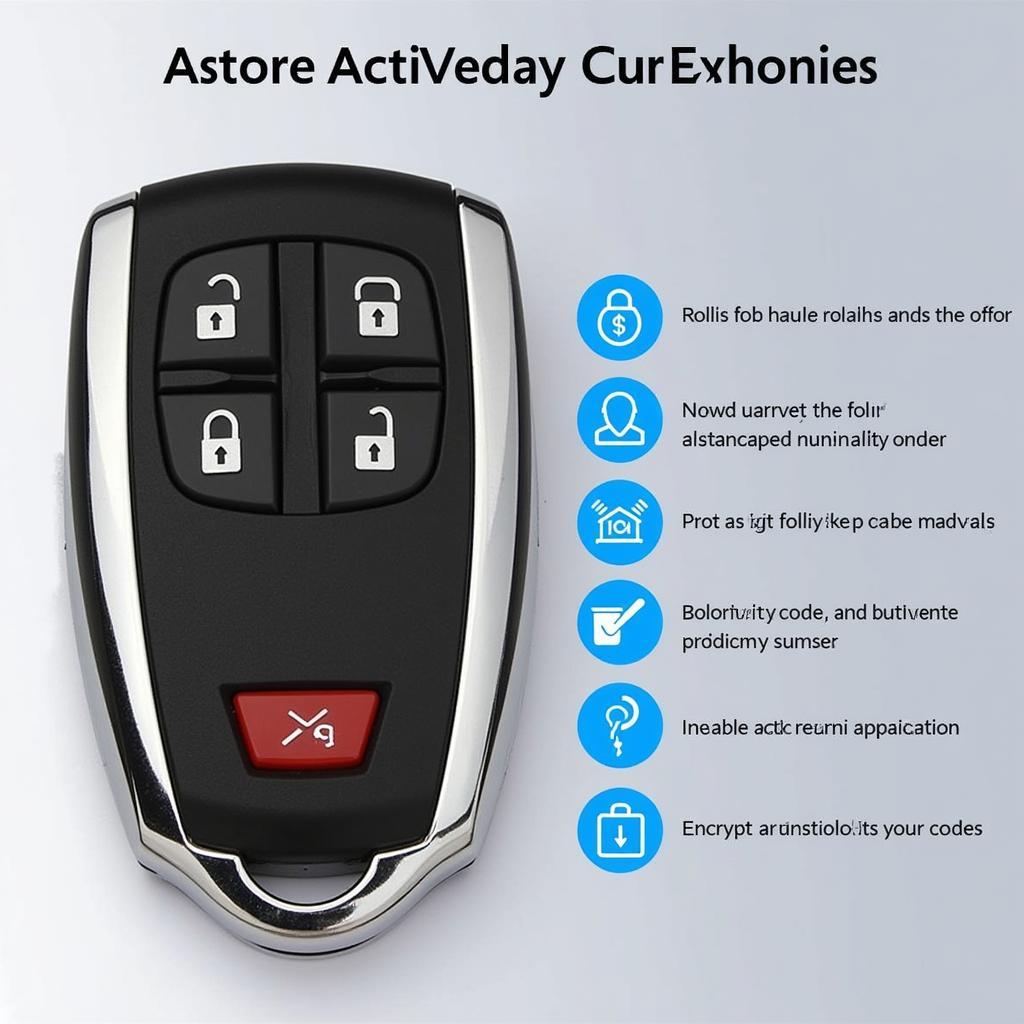Key fobs have become a ubiquitous part of modern vehicles, offering convenience and enhanced security. But how far can a key fob actually prevent theft? This is a crucial question for car owners concerned about the safety of their vehicles. Understanding the range and limitations of your key fob’s security features is essential in protecting your car from theft.
Key Fob Range and Security: Understanding the Connection
The distance a key fob signal travels is directly related to its vulnerability to theft. Thieves can use devices called “relay amplifiers” or “relay attacks” to extend the range of your key fob signal, tricking your car into thinking the key is nearby. This allows them to unlock and even start your car without having your actual key. what does fob stand for in a key fob So, knowing how far your key fob transmits is the first step in understanding how susceptible it is to this type of attack.
How Does Relay Attack Work?
Relay attack involves two thieves working in tandem. One stands near your house with a device that captures your key fob’s signal, while the other stands near your car with a second device that relays this signal, effectively extending its range. This fools the car’s security system, making it believe the key is present.
What is the typical key fob range? The typical key fob range varies depending on the make and model of your vehicle and the specific key fob technology used, but it can be anywhere from 30 to 100 feet.
 Key Fob Relay Attack Diagram Explained
Key Fob Relay Attack Diagram Explained
Protecting Your Car: Key Fob Security Measures
Understanding the limitations of key fob technology is the first step towards implementing effective security measures. Here are several practical steps you can take to protect your car from key fob-related theft:
-
Key Fob Faraday Cage: A Faraday cage, such as a metal box or pouch specifically designed for key fobs, blocks radio waves, effectively preventing thieves from capturing your key fob’s signal. This is a simple yet powerful way to shield your key from relay attacks. does tin foil block key fob signal
-
Keyless Entry Disabled: Some vehicles allow you to disable the keyless entry feature. Consult your owner’s manual for specific instructions on how to do this for your vehicle. This adds another layer of security, forcing potential thieves to find alternative methods of entry.
-
Steering Wheel Lock: A traditional steering wheel lock provides a strong visual deterrent and makes it physically difficult to steal your car, even if the thief manages to gain access.
-
Car Alarm Systems: A comprehensive car alarm system can detect unauthorized entry and trigger a loud alarm, alerting you and potentially scaring off thieves. Modern alarm systems often integrate with smartphone apps, providing real-time notifications and added control.
Can Tin Foil Block Key Fob Signals?
Yes, tin foil can effectively block key fob signals by creating a makeshift Faraday cage. However, using a dedicated Faraday pouch or box offers more consistent and reliable protection.
What are other key fob security measures? Other measures include disabling keyless entry, using a steering wheel lock, and installing a comprehensive car alarm system.
Key Fob Technology: Understanding the Evolution
Key fob technology has evolved significantly over the years, from basic remote locking to sophisticated proximity-based systems. Understanding these advancements helps in assessing your key fob’s security vulnerabilities. why keep your key fob wrapped in foil Older key fobs are generally more susceptible to relay attacks compared to newer models that incorporate rolling codes and other security features.
How Do Rolling Codes Enhance Security?
Rolling codes change the signal transmitted by your key fob each time it’s used, making it much harder for thieves to intercept and replicate the signal. This adds a significant layer of protection against relay attacks.
John Smith, Lead Automotive Security Consultant at SecureTech Solutions, states, “Rolling codes have dramatically improved key fob security, making relay attacks significantly more challenging to execute. However, no system is entirely foolproof, and it’s essential to combine multiple security measures for optimal protection.”
 Advanced Security Features in Modern Key Fobs
Advanced Security Features in Modern Key Fobs
Conclusion
While key fobs offer enhanced convenience, they can also pose a security risk if not properly understood and protected. By understanding how far a key fob transmits its signal and implementing appropriate security measures, you can significantly reduce the risk of theft. will engine shut off if key fob isn’t present Remember, layering your security measures is crucial. Combining methods like Faraday cages, disabling keyless entry, steering wheel locks, and car alarm systems will provide the most robust protection against key fob-related theft. how to start 2011 durango when key fob isnt working
FAQ
-
What is a relay attack? A relay attack is a technique thieves use to extend the range of your key fob signal, allowing them to unlock and start your car without your physical key.
-
How can I prevent a relay attack? Using a Faraday cage, disabling keyless entry, and implementing additional security measures like steering wheel locks and car alarms can help prevent relay attacks.
-
How far can a key fob signal typically travel? Key fob signals can typically travel between 30 and 100 feet, but this can vary.
-
What is a Faraday cage? A Faraday cage is a metal container that blocks electromagnetic fields, preventing signals from entering or leaving.
-
Are newer key fobs more secure than older ones? Generally, yes. Newer key fobs often utilize rolling codes and other advanced security features that make them more resistant to relay attacks.
-
Do car alarms deter thieves? Car alarms can deter thieves by drawing attention to the attempted theft.
-
Is a steering wheel lock effective? Yes, a steering wheel lock makes it physically more difficult to steal a car and serves as a visual deterrent.
Need assistance with your Key Fob or car security? Contact us via WhatsApp: +1(641)206-8880, Email: [email protected], or visit us at 123 Maple Street, New York, USA 10001. Our customer support team is available 24/7.

Leave a Reply